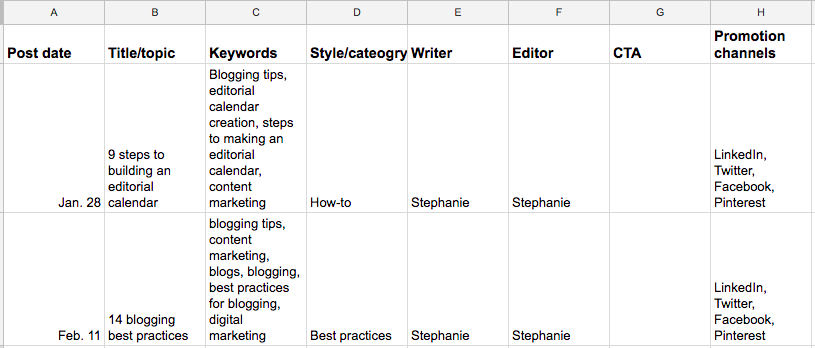
9 steps to building an editorial calendar
Note: I originally published this same article through my LinkedIn.
In today’s world of content marketing brands must think and act like publishers by sharing quality, relevant content around their brand and their customers’ needs. To help with creating quality, relevant content, a good place to start is an editorial calendar.
What is an editorial calendar? A great definition by Brian Honigman on Lynda puts it as: A written document that organizes the timing of your content production, publishing, distributing, and measurement efforts.
Essentially, it’s a way of strategically organizing your marketing campaigns and content pieces. The two key words here are strategic and organization. Your brand’s editorial calendar is meant to make planning and executing content easier by keeping everyone on the same page – or calendar.
Editorial calendars come from the publishing world, like magazines and trade publications, and are very applicable to modern content marketing efforts. One of the best blogging tips I can share is to create editorial or content calendars to keep yourself on track.
So, what do you need in order to create an editorial calendar? I’m going go through the nine steps to building out an editorial content calendar for your content marketing strategy.
1. Identify business goals
First, you want to start with outlining your brand’s business goals, like driving brand awareness, generating leads, retaining customers, or establishing yourself as a thought leader to gain trust of prospects.
All of your content marketing efforts need to be centered around these business goals, but keeping in mind that most content marketing efforts are subtle sales pitches, not direct sales collateral.
2. Understand your customers’ goals
Next, you need to think about your customers and who you’re producing content for. What are they looking for within your content marketing pieces? How will they find your content? And, what metrics will you use to measure success? By finding the perfect marriage between your business goals and your customers’ goals, you can create content they want and content that drives action.
3. Assemble your team
Now, you need to know who your content creators are or who specifically is developing the content. Is it a few people from one department or are other stakeholders helping out? What collaborators are using the calendar and what level of access do they need? Who is the content manager and in charge of making changes to the calendar and pieces of content?
By knowing how many people are contributing, you can start to draw out the structure of your calendar and what kinds of columns or tabs you’ll need to include to keep track of everything that’s going on.
4. Decide if you need a tool
If your team is small or your content marketing efforts aren’t too complex, you can get away with spreadsheets or free online calendars to organize your plan. I most often use Google Sheets for simple content marketing projects but if a project starts to have a lot of moving parts or requires more collaborators, I’ll use something like Trello to keep everything organized.
If you’ve got a really big team or want integrations with WordPress and social media, see if using an editorial calendar tool like CoSchedule is worth it. It does not have a free version, but its features are specifically designed for content marketing and can save your content team hours when it comes to creating, publishing, and promoting content.
5. Outline events, campaigns, and holidays
Similar to identifying business goals, the next step is to outline all big campaigns, company events, and even holidays you need to support or pay attention to with your content. This keeps your content organized and on theme and helps mitigate any risk of realizing too late there’s a big sales campaign on the horizon.

6. Keyword brainstorm
So, you have your business goals, customers’ needs, and campaigns in mind, it’s time to start brainstorming keyword terms to map to specific posts. Start with general keyword terms for your business. After the next step, you’ll do another keyword brainstorm to map specific keywords to specific psts.
7. Topic generation
Now start brainstorming different topics that are relevant to your brand and its keywords, your customers, and that would be exciting to create and promote. Do a free write where there are no bad ideas – you can always eliminate later but at least it gets you thinking outside the box. Some traditional blog styles include:
- X things to do/know/see/learn about/avoid/secrets to
- Tips and tricks
- Guides
- How-tos
- Interviews
- Reviews or roundups
- Comparisons
- Predictions
- Seasonal
- Hyperlocal
- News
Try to include a mix of evergreen content, content that’s relevant for a long time, as well as timely content. Change up the variety of your post types and think ahead of any ways you can repurpose your content, like videos, infographics, eBooks, etc.
8. Create your calendar
Then, you’ll map out specific topics and posts in your blog’s editorial calendar to certain posting dates.
Here’s a simple structure for building a content calendar:
- Publish date
- Topic/title
- Keywords
- Notes
- CTA
- Promotion channels

Organize your calendar in a way that makes it easy for you to read and understand, and assign out any writing projects to the rest of your team.
9. Measurement
Finally, you’ll want to have a plan in place for measuring the results of your content. This can be done by figuring out what metrics you want to track in Google Analytics and looking at any metrics in social media insights you want to use to determine if a piece was successful.
For Google Analytics, you’ll be looking at:
- Traffic
- Site content
- Pageviews
- Channels/referrals
- Time on site
- Bounce rate
- Behavior flow
- Demographics
For social metrics, you’ll be looking at:
- Engagement rate
- Click-through rate
By tracking these metrics, you can start to gauge what topics your target audience is interested in and understand more about your audience to further refine any buyer personas you’ve developed.
Hopefully these tips get you started with creating an awesome content calendar for your own content marketing and blogging efforts!




